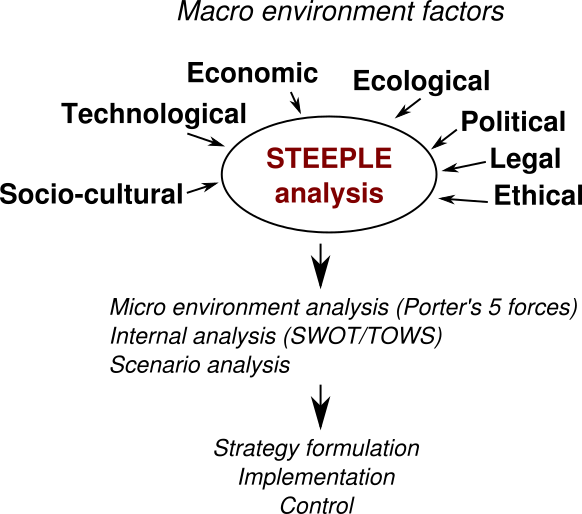PESTEL analysis
| STEEPLE analysis |
|---|
| See also |
STEEPLE analysis is one variant of the very popular and simple strategic management method for analysis of external environment of the organization. It is based on PEST analysis method, with addition of additional Environmental, E thical and L egal factors. It has other variants, which only have different order of factors: SLEPT analysis, PESTLE analysis and PESTEL analysis. In PESTLED analysis additional Demographic factor is added.
Main factors of STEEPLE analysis
Five external factors influencing organization is considered:
- S ocio-cultural - social forces influence our attitudes, interests, opinions, moreover create our behavior and ultimately what we purchase. Trends’ changes have correspondingly direct impact on enterprises. These factors contain: structure of population, falling rates, competition, increase of global population, traditions, level of education, cultural diversity and standards. More examples of Social and cultural factors affecting business.
- T echonological - technological advances have greatly changed the manner in which businesses operate. Nowadays technological progress created a society which expects instant results. Here we can mention: new technologies, absorptive capacity for innovation, globalization. New technologies shorten Product life cycle and increase demand for new products. This revolution has increased the rate at which information is exchanged between stakeholders. A faster exchange of information can benefit companies as they are able to react quickly to changes. More examples of Technological factors affecting business.

Fig. 1. Place of STEEPLE analysis in strategic management process
- E conomic - national interest rates and fiscal policy is set around economic conditions, besides has influence on purchasing power of consumers and structure of their expenditure. These factors include: gross domestic product (GDP) creating by demand, stock quote, currency rate fluctuations, rate of inflations, market substitutive and complementary, tax policy, price changes, revenues, savings and level of unemployment. More examples of Economic factors affecting business.
- E nvironmental - environmental protection legislation, pollution, waste management and disposal, clean air and water, energy saving technologies, attitudes towards ecology in society. More examples of Ecological factors affecting business,
- P olitical - factors could create plenty of advantages and opportunities for organizations. These factors include: political situation, political stability, state interference, market regulations, trade agreements, tariffs or restrictions, taxes, lobbying and clarity of law. More examples of Political factors affecting business,
- L egal - (subset of above mentioned political factors) involve all regulatory and law determinants that can negatively or positively affect results of market actions and decisions of management of company functioning in particular country. International companies must analyze and identify those factors (legal environment) independently for every state they function. More examples of Legal factors affecting business.
- E thical factors involve duties, morality, integrity, behaviour, what is good and bad for company, employees and society as a whole. More examples of Ethical factors affecting business.
Above mentioned external environment factors, can have both positive influence (then they are called opportunities) or negative influence (and then they are called threats).
References
- Bowman, C. (1998). Strategy in practice (p. 201). Prentice Hall Europe.
- Pearce, J. A., Robinson, R. B., & Subramanian, R. (2000). Strategic management: Formulation, implementation, and control. Columbus, OH: Irwin/McGraw-Hill.
Author: Krzysztof Wozniak

